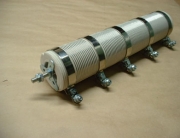Power Resistor – ASW Series Application Example
The ASW series power resistor by nature of its construction lends itself to high current in rush applications and have excellent impulse tolerant characteristics. Deigned primarily for printed circuit board mounting applications they have been used in products ranging from UPS’s, D.C. to D.C. converters, electrical metering and power conversion circuits.
Electrical Metering Application For Power Resistor
The ASW 2 precision wound power resistor is rated at 3 watts and has an available resistance range from 0.5 ohms to 1800 ohms and  has available tolerances ranging from 1 percent to 5 percent. A client was developing a high end electric meter which was designed to replace the traditional ‘spinning wheel’ electrical meters that have been used around Australia for more than 50 years to measure residential electrical usage. Whilst these meters have had an excellent track record of reliability, they represent outdated technology and the power retailers were looking to ‘roll out’ a new generation of electricity meter that offered the benefits of easy meter reading, wireless interface and accuracy.
has available tolerances ranging from 1 percent to 5 percent. A client was developing a high end electric meter which was designed to replace the traditional ‘spinning wheel’ electrical meters that have been used around Australia for more than 50 years to measure residential electrical usage. Whilst these meters have had an excellent track record of reliability, they represent outdated technology and the power retailers were looking to ‘roll out’ a new generation of electricity meter that offered the benefits of easy meter reading, wireless interface and accuracy.
High Current Inrush Requirement
The client is their electronic circuit design needed a power resistor on the input side of the circuitry that was capable of handling potentially high impulse and in rush of a.c. electricity from the grid. Samples of the ASW 2 power resistor were supplied to the client for evaluation where they used in house pulse simulation testing techniques to rigorously test the performance of this resistor under high current inrush situations. The resistors performed extremely well and proved to offer high reliability under multi-impulse testing. Given that the expected field life of the finished metering products would exceed 15 years, the long term reliability of these power resistors was critical to the long term success of the finished product.
Packaging Of The Resistors
The electronic metering unit was designed using predominantly surface mount technology, however there were a number of larger, ‘through hole’ components that needed to be assembled on the circuit board using automatic insertion equipment, commonly used within the electronic contract manufacturing industry. To facilitate automatic insertion, the ASW series power resistors were supplied to the client in a ‘tape and reel’ packaging format, where the discrete resistors are ‘packaged’ onto a bandolier arrangement which can be loaded efficiently onto automatic insertion equipment. This allowed for cost effective insertion of the resistor leads into the printed circuit board.
Conclusion
Selecting the correct resistor for high current inrush applications is very important. The internal construction of different types of wire wound resistors lend themselves to different applications. By thoroughly testing in circuit different types of resistors and applying the load and over load conditions that the resistor is likely to be subjected to in ‘real life’ situations, clients can ensure that the resistor will perform reliably for many years.

